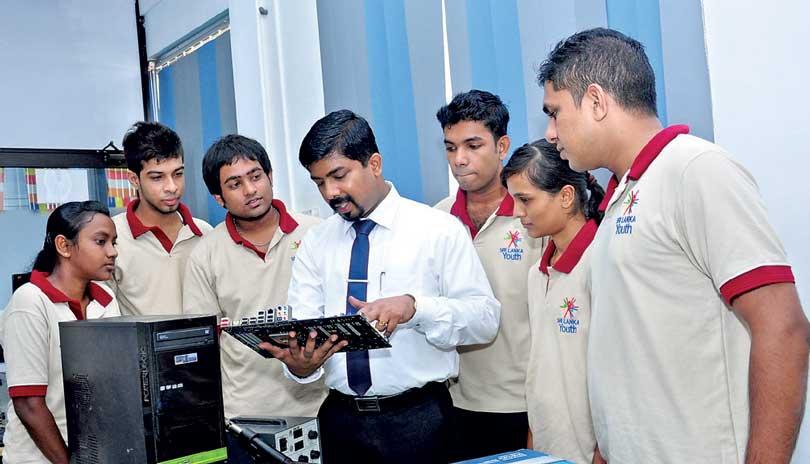Reply To:
Name - Reply Comment

 Sri Lanka has long been regarded as a model of a successful welfare state - yet it has for decades faced major challenges in providing employment and meeting the aspirations of youth.The World Bank, in one of its reports, quotes two reasons for youth unemployment in Sri Lanka. (1) Competing hypotheses of unemployment and (2) Inaccessibility of quality education and training.
Sri Lanka has long been regarded as a model of a successful welfare state - yet it has for decades faced major challenges in providing employment and meeting the aspirations of youth.The World Bank, in one of its reports, quotes two reasons for youth unemployment in Sri Lanka. (1) Competing hypotheses of unemployment and (2) Inaccessibility of quality education and training.
World Bank classifies the first reason into three categories: (a) The unrealistic wage expectations: Educated unemployed youths seek jobs which would pay them more than the market is willing to, (b) The queuing: The unemployed youths wait for an opportunity to take “good” jobs: e.g., Government service or semi-government sector. (c) The institutional: Most private firms create “just the minimum” number of jobs because they face high labour costs.
Regarding the second reason - inaccessibility of quality education and training. It can happen due to many reasons. Absolute poverty of the family, schools not in proximity, No proper learning facility in the school, unavailability of quality teachers, discrimination at school or by society can be few of the reasons.
Youth unemployment
Youth unemployment has become a major issue in Sri Lanka. According to Statista – a German portal for statistics – with one of the most successful statistics databases in the world, says the estimated youth unemployment rate in Sri Lanka was at 22.5 percent in 2017 and by 2018, it has arisen to 23.17.
However, Central Bank maintains the youth unemployment rate is 18.5 percent in 2017. Even if we take the Central Bank’s figure for our comparison purposes, our youth unemployment rate is exceeding the global rate by 5.5%. Going further in the Central Bank’s calculations, we note that our youth unemployment accounts for 50 % of the total unemployment. Worst of all, our youth unemployment rate is four times higher than the overall unemployment rate.
For a country like Sri Lanka, competing in today’s global economy is a complex issue. We not only need advanced technical and vocational skills, but also a flexible workforce that can adjust to rapid shifts in demand. That is why investing in appropriate skills development program is so vital to our economic growth and competitiveness.
In particular, our secondary education systems must be oriented towards producing youth who have both strong foundational skills as well as specific skills for jobs. Many of our youths have the appropriate academic qualification for a job but lack the soft skills or technical skills to convert knowledge into a profession. Sri Lanka’s labour market clearly reflects a skills mismatch.
TVET System
Just like many other countries in the world, we too have a TVET (Technical and Vocational Education and Training) system characterized by a multitude of agencies. It includes training providers of public and private sectors, standards and curriculum development agencies and a regulatory body. The Tertiary and Vocational Education Commission (TVEC) serves as the sector’s apex body.
Our TVET sector operates through a nationwide training service network with an annual enrolement around 200,000 students. Public TVET service providers account for 71 % of the total service network, private sector 19 % and NGOS 10 %. However, according to an ADB report in 2015, about 28 percent of the unemployed having TVET training did not process right skills for the right job revealing a skills jobs mismatch and a shortage of talent.
If nearly one-third of the trainees were not able to secure jobs of their choice, it is obvious that something is amiss in out TVET system.In the meantime, our youth unemployment is static during the past 12 years wavering around 20 %. These are distressing facts.
An ideal TVET System is an employer-led skills development structure anchored on research, policy and strategic planning. It is based on analysis of needs and priorities of the fast-changing labour market. These information and statistics need to be taken for consideration when the development of job profiles, standards, qualifications, and curriculum development are done. If planned and executed well, there cannot be any noticeable mismatch between skills available and job openings.
It’s time we take a hard look at our current TVET system and evaluate what reforms are necessary to revolutionise our technical and vocational education and be a world-class example.
Singapore experience
While some Sri Lankans continue to see vocational training as a “last resort” for students who have not done well academically, more countries around the world are adopting the time-tested skills-training programmes. One such country is Singapore. What is so special in Singapore?
A report by Organisation for Economic Cooperation and Development (OECD) notes that a major source of Singapore’s competitive advantage lies in the ability of the government to successfully match supply of job openings with demand of education and skills. It also praised a culture of continuous improvement, strong and unwavering leadership, vision and alignment between policy and practice as among the key attributes of successful TVET development in Singapore.
Let us briefly analyse how they run the system.Singapore has two important programs related to vocational training: the Pre-Employment Training (PET) and the Continuing Education and Training (CET).
PET education categories have grown over the past few decades, particularly the universities, polytechnics and Institutes of Technical Education (ITE). These institutions are collectively encapsulated within the term pre-employment training or ‘PET’. They are well recognised in both Singaporean society and internationally. They prepare learners for entry into the workforce, providing them with a broad, general education, academic development and in the case of ITE and the Polytechnics, rounded and high-quality technical and vocational preparation for moving into first jobs. Secondary school graduates can proceed to academic or vocational route depending on their school grade, and those who follow Vocational training and continuing education for employability in Singapore and the academic route will need to complete Junior college (2 years) or polytechnic diploma (3 years) before entering university.
Graduates from polytechnics are considered job-ready but many seek to upgrade to a degree as the expected salary and career progression of polytechnic graduate is lower than a university graduate.
Secondary school graduates who were not admitted to academic route can enter the formal vocational schooling at the Institutes of Technical Education (ITE). ITE is the principal provider of vocational and technical education in Singapore at the technician and semi-professional level. After vocational education, the graduates may opt to start on a job or continue further studies in other institutions.
The aim of ITE education is to equip students with the technical knowledge to meet the workforce needs of different industries. About 25% students in Singapore go to ITE for full-time study as continuance of their secondary schooling; and generally, 90% of ITE graduates found jobs within six months of graduation.
In terms of ITE tuition fees, Singapore citizens are charged a modest fee and financial assistance schemes are available to citizens depending on household’s income.
Other than ITE there is another national credentialing system called Workforce Qualification System (WSQ). The Singapore WSQ system is a national continuing education and training system designed for adult workers which complements the formal education system for students. WSQ training is accessible to all workers and does not require academic pre-requisites. The WSQ provides training for skills upgrading and also recognition and certification of workers’ existing skills. There are seven qualification levels from basic Certificate to graduate Diploma and these spells out the upgrading and career advancement pathways for workers.
The Singapore Government has emphasised its commitment to economic growth based on skills, innovation and productivity involving the development of “an outstanding, comprehensive, nation-wide Continuing Education and Training CET system”, where learning and acquiring new skills throughout life becomes the norm for every Singaporean.CET offers educational programmes for adults, usually at the post-secondary level and offered as part-time or short courses in occupational subject areas.
Workforce Skills Qualifications (WSQ)
The Workforce Skills Qualifications (WSQ) as the national credentialing system is key to facilitating transition from the traditional Pre-Employment (PET) sector towards the continuing education and training (CET) sector. WSQ was designed to help workers to gain jobs, advance in their jobs, move into new jobs, make the transition between jobs and even across industry sectors – commonly referred to as the “4 Ms”: move into work, move up in position, move between organisations and move across industry.
There are three skill sets that form the basis of WSQ: occupational skills, industry skills, and employability skills. Occupational skills are job specific skills required to perform one’s work. Industry skills are broad industry skills and knowhow. Employability skills are generic and portable skills applicable for all industries.
The WSQ qualifications have six levels – from Certificate to Graduate levels. WSQ courses have been designed to be competency-based, work- and job-focused, vocational in nature, industry-led and appropriate for adult learners. These qualifications are provided by a range of public and in-house training providers. The development of WSQ includes close collaboration with industry and Training Councils.
Singapore government’s commitment to skills deepening is seen in the generous subsidies it offers. Course fee subsidies range from 50-95% for self-sponsored individuals. On top of the course fee subsidy, a training allowance is also given.
Singapore experience offers some food for thought for our TVET developing professionals.